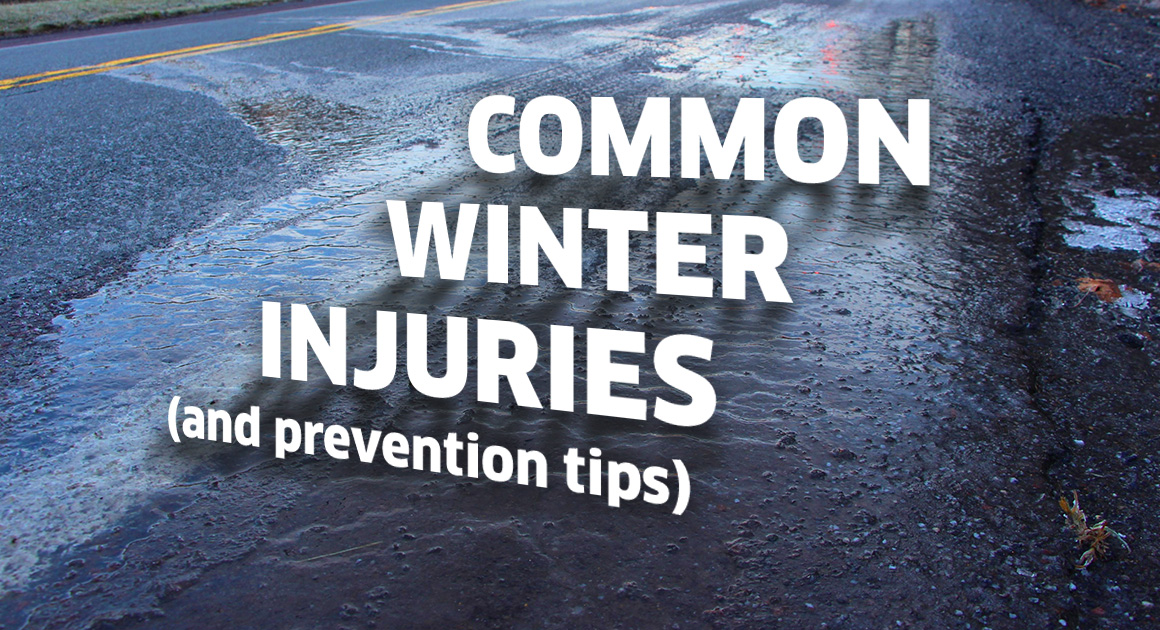It is hard to imagine that Old Man winter is just around the corner when you rarely need a jacket after lunch thus far into the fall season, yet the snow and icy conditions are on the way. According to the CDC, unintentional injuries account for nearly 40 million emergency room visits each year and while that number is not specific to winter injuries, being prepared for the upcoming winter weather is the best option. Continue reading for more information on common winter injuries and prevention tips.
- The most common winter injuries are related to slips and fall on wet or icy surfaces. These slip and fall accidents result in wrist fractures, hip fractures, spine fractures or of lesser severity, bruised or stiff muscles. These types of winter injuries are not limited to senior citizens as you may think, but instead, can happen to anyone at any time.
Prevention Tips:
- Appropriate Shoes/Boots: Wear shoes or boots with thick rubber soles if possible. Increasing the contact surface area of your foot will improve your traction on slippery surfaces.
- Time: Slow down! Give yourself extra time to arrive at places. Smaller, shorter steps allow your body to acclimate to slippery surfaces and avoid falling.
- Alertness: This goes without saying, put your phone in your pocket. The visual input of slippery surfaces forewarns your physical self to be prepared.
- Avoid: If possible, stay inside or bypass walking outside.
- Shoveling is a winter activity that most people cannot escape. While low back injuries are the most common winter injury related to shoveling, cardiac arrest or other heart-related problems also occur.
Prevention Tips:
- Be realistic: If you have difficulty walking up a flight of stairs, have high blood pressure or become out of breath walking through snow, it would be best to recruit help from neighbors to shovel your sidewalks. It has been estimated by the CDC that 15-20 minutes of shoveling snow is considered moderate exercise which is equivalent to running 1.5 miles in 15 minutes, (Physical Activity and Health: A Report of the Surgeon General, cdc.gov.)
- Use proper body mechanics: A typical shovel full of snow can weigh 20-50 lbs. Attempt to push the snow and avoid the motion of lifting while twisting. Keeping your core muscles tight with all shoveling activities will give your low back extra support.
- Listen to your body: Stretch before and after shoveling, take breaks and stop if you become short of breath or experience any type of pain.
- Hypothermia and frostbite may not be top of mind awareness when you think of common winter injuries and prevention tips. Hypothermia occurs when the body’s core temperature drops below 98.6 and can no longer produce enough energy to keep warm. While hypothermia can be more severe than frostbite, both are preventable.
Prevention Tips:
- Common Sense: Stay inside or seek shelter in severely cold temperatures.
- Dress Appropriately: Wear clothing relevant to the weather outside, but also be mindful of becoming chilled and or sweating in cool weather.
- Know the signs and symptoms of both hypothermia and frostbite and seek shelter and treatment immediately. For a complete list of signs and symptoms, please visit cdc.gov/winter weather.
- Hypothermia: Shivering, Confusion, Loss of coordination.
- Frostbite: Redness or pain at exposed area, waxy look, and numbness.
The above listed are just a few of the most common winter injuries reported and their prevention tips. Unfortunately, the prevalence of injuries related to car accidents dramatically increases with winter weather conditions, as well as exposure to carbon monoxide and burns related to sitting in running cars and usage of portable heaters. Winter weather is just around the corner and while some of these prevention tips may feel like common sense, it never hurts to be prepared.
If you have any other common winter injuries and prevention tips you’d like to share, please leave a comment or reply here.

